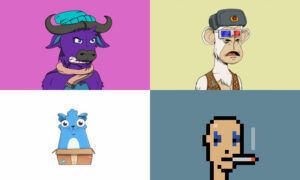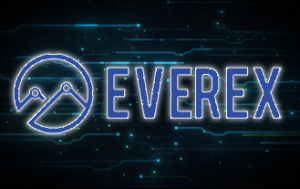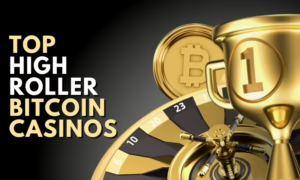10 Interesting NFT Facts
Today we will be taking a look at 10 interesting facts about digital artworks known as NFTs (Non-fungible tokens).

A non-fungible token (NFT), is a unique and non-interchangeable unit of data stored on a blockchain. Essentially it is a method of creating a digital certificate of ownership of a digital artwork or asset that can be bought, sold and used on the associated blockchain. However, as with most things crypto, 2017 was the year when NFTs really began gaining wider recognition with the introduction of blockchain-based games such as CryptoKitties.
1. The First NFT Came Out in May 2014
The first NFT ever created was a short video NFT created by digital artists Kevin McCoy and Anil Dash on May 3rd, 2014. It was called ‘Quantum’ and was minted on the NameCoin blockchain. It was a short video clip featuring Jennifer McCoy, the wife of one of the artists. This is significant, since it predates the Ethereum blockchain altogether, which is where must NFTs are produced in the form of ERC-721 tokens.
2. The Most Expensive NFT Cost $91.8 Million USD
Anonymous NFT artist Pak is famous for his ‘The Fungible Collection’ whose pieces are auctioned off to the highest bidder over a set number of days. Most of their artworks rake in over $1 millions USD in sales. However, the prize goes to ‘The Merge’ which was sold to a group of 28,983 collectors for $91.8 million USD on December 7, 2021, on Nifty Gateway.
3. Total No. of Ethereum NFTs Doubled in the First Four Months of 2022
By April 17th, 2022, the number of NFTs on the Ethereum network had reached 80,300, in contrast to the 15,540 that had been on the network a year prior. That is an increase of over 400% over the full year. Interestingly, despite the current ‘crypto winter’ that has been experienced since November 2021, NFTs in contrast went up to a trading volume of over $54 billion USD by April 17th, 2022, although from there it declined to $672 million USD by June 30th, 2022.
4. Each NFT Is Unique

An NFT is a digital asset that is minted on the blockchain. It is stored as a piece of data on a blockchain ledger, meaning that it cannot be duplicated or stolen (at least theoretically) as proof of ownership is stored via smart contract on the blockchain. Furthermore, all transactions are conducted through smart contracts which means that there can be no double-sales, failure of payment or other scams, as it is the blockchain’s protocol, rather than the individuals, which fulfils the terms of the smart contract once both e-wallets have signed it. But the most important trait of an NFT lies in its name – namely that it is non-fungible, meaning that it has its own unique signature and identity, much like the blockchain-based breeding or CCG upgrade games, although there are also many that are simply artwork and offer no potential earning value beyond investment, much like real-world art.
5. 2021 Was the Year of the NFT
2021 was to NFT what 2017 was to crypto. Even though NFTs had been around for years, they really gained widespread recognition and demand in 2021. However, this was also the year of the second crypto bubble, so it is possible that they were interlinked. Nonetheless, with almost $41 billion USD spent on NFTs through trades involving over 28.6 million wallets in 2021, and sales already hitting $42 billion USD in the first half of 2022 alone, it seems that the NFT craze isn’t about to peter out just yet.
6. There Are NFT Bidding and Sale Sites
From digital pets to fighting games to unique aesthetic in-game loot, the NFT market seems to be paving the way for a more dependable digital asset market. Most NFT enthusiasts will have heard of OpenSea and which are exclusive NFT sale sites, but what is less expected is that even traditional platforms have begun hosting NFT bidding and sales, such as Sotheby’s.
7. Artists Can Automatically Receive Royalties from Future Sales

Thanks to the nature of smart contracts, it is now possible for artists to ensure that they automatically receive remuneration for all sales of their work. An example of this are MarkersPlace and NFT Showroom, which will take a commission on sales of the artist’s piece, while also ensuring that the artist gets a percentage of each resale that occurs on their platform as well.
8. Millennial Men Are Most Likely to Invest in NFTs
According to Statista, as of May 2022 the between US-based GenZ’s and millennials, millennials were far more likely to purchase NTFs and so too men over women were more likely to be interested in investing in them. Additionally, it was found that Chinese tech giants are most interested in created and trading in NFTs. However, like Reddit, China’s group of industry of associations are leaning towards only accepting fiat over cryptocurrency in exchange for them.
9. CryptoPunks Were the First Mainstream NFTs
First released in June 2017, CryptoPunks are a collection of 10,000 limited edition, unique characters that were generated on the Ethereum blockchain. They were originally released for free to whoever claimed them, but they now sell for millions of USD dollars apiece. They were so popular that they served as the inspiration for the ERC-721 tokens that we are now familiar with.
10. NFTs Can Be Used as Collateral
Cryptocurrency lending platforms such as NFTfi enable their platform users to lend and borrow cryptocurrency while using NFTs as collateral. The interest rate and repayment date is built into the smart contract, so if the borrower forfeits, the lender will automatically be able to lay claim to the NFTs. There are some even lenders who lend their crypto in the hopes of getting a CryptoPunk or Axies at a discount through a forfeited loan.







